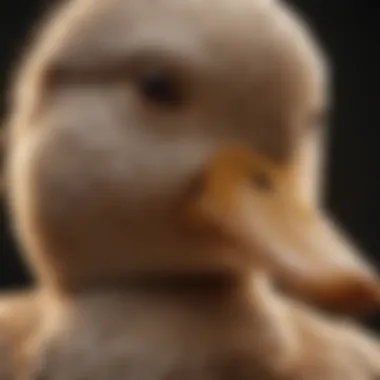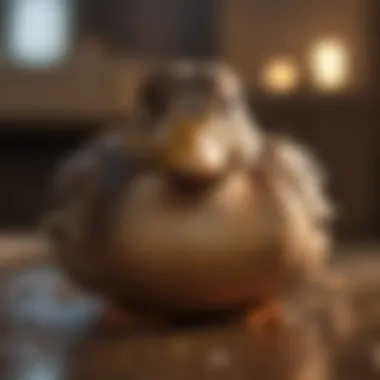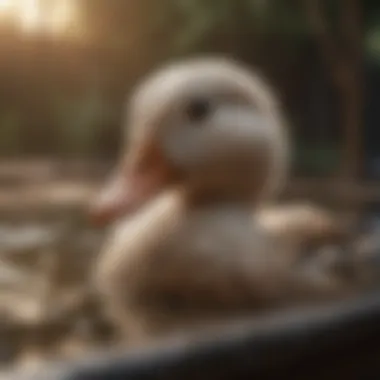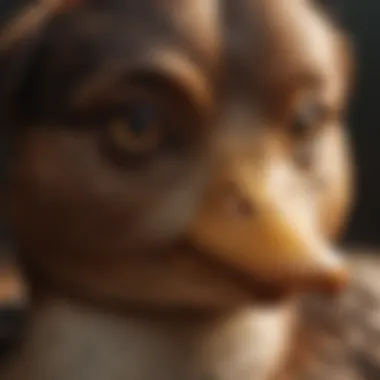Understanding Duck Vent Health and Maintenance


Intro
Understanding the health and maintenance of duck vents is crucial for anyone who owns these charming birds. A duck's vent, also known as the cloaca, plays a significant role in their overall well-being and functionality. This opening is responsible for excretion, reproduction, and laying eggs. Given the vital functions it serves, proper care and maintenance are imperative. This article will examine the anatomy, health concerns, and practical care tips, providing essential insights for both new and seasoned duck owners.
Grooming Techniques
Grooming is not only about aesthetics; it significantly contributes to a duck's health. Regular grooming helps keep the vent clean and free from blockages, which can lead to infections.
Basic Grooming Tools
Having the right tools is essential for effective grooming. Some basic tools include:
- Soft-bristled brush: Ideal for gently removing dirt and debris from feathers.
- Clippers or scissors: Useful for trimming feathers around the vent area, as excess feathers can trap moisture and waste.
- Cleaning solution: Mild anti-bacterial solutions help disinfect the area.
Step-by-Step Grooming Guides
- Prepare the Area: Choose a calm environment where the duck feels secure.
- Hold the Duck Gently: Make sure to support its body adequately.
- Clean the Vent Area: Use the soft-bristled brush, followed by a damp cloth with the cleaning solution to wipe the vent area.
- Trim Excess Feathers: Carefully trim any long feathers around the vent that may gather dirt.
- Check for Injuries or Blockages: Always look for signs of irritation or blockage after grooming.
Breed-Specific Grooming Needs
Different breeds may have specific grooming requirements. For instance, Pekin ducks require more frequent cleaning due to their heavy feathering, which can trap moisture. On the other hand, Khaki Campbells might need less grooming as their feather density is usually lower.
Health and Wellness
Regular health checks can prevent serious problems, promoting a long and happy life for your ducks.
Nutrition and Diet Tips
Proper nutrition is the foundation of good health. Ducks thrive on a balanced diet that includes:
- Duck pellets: Ensure they are high in protein and provide essential nutrients.
- Fresh greens: Leafy vegetables like kale and lettuce aid in digestion.
- Grains: Whole grains are excellent for energy.
- Clean water: Always provide fresh, clean water for drinking and bathing.
Common Health Issues and Solutions
Ducks may face various health concerns, including:
- Vent Gleet: Inflammation of the vent caused by bacteria or yeast. Treatment includes antibiotics prescribed by a veterinarian.
- Mites and Lice: Infestations can cause discomfort. Regular inspection and treatment with appropriate products are necessary.
Importance of Regular Check-Ups
Seeing a veterinarian regularly is vital for monitoring general health and catching issues early.
Training and Behavior
Understanding a duck's behavior is crucial for effective care.
Basic Training Commands
Teaching commands such as
Prelude
Understanding duck vent health is an essential aspect of avian care that often goes unnoticed by pet owners. The vent, also known as the cloaca, serves multiple roles in a duck's physiology, including excretion and reproduction. By recognizing the significance of this organ, owners can greatly improve the overall well-being of their ducks.


Regular monitoring of vent health allows for early detection of potential issues. Ducks are susceptible to various health problems that originate from or affect the vent area, such as infections or blockages. Maintaining proper hygiene and nutrition contributes to optimal vent function, directly influencing a duck's overall health.
In this article, we will explore the anatomy and function of the duck vent, common health issues, and effective maintenance practices. Understanding these elements can help prevent potential complications while ensuring ducks thrive in a safe and healthy environment. Moreover, knowledge of this topic empowers owners to act proactively in caring for their pets, rather than reactively addressing problems as they arise.
Proper care of duck vent health is not only about addressing issues when they occur, it involves adopting a holistic approach that includes preventative measures. Fostering an understanding of the link between vent health and the overall health of ducks could lead to happier, more resilient birds.
By addressing these critical factors, this article serves as a valuable resource for both novice and experienced duck owners, emphasizing practical tips and expert insights for optimal care.
Anatomy of the Duck Vent
The anatomy of the duck vent is fundamental for understanding how to maintain a duck's overall health. This section will discuss the definition, location, structure, and function of the vent, which plays a crucial role in various physiological processes.
Definition of Duck Vent
The duck vent, often referred to as the cloaca, is an anatomical part where the intestine, urinary tract, and reproductive systems converge. This single opening facilitates multiple bodily functions. It is important to understand that the vent is not merely a waste exit; it serves several roles vital to the duck's overall health. Ensuring its function is optimal can help prevent various health problems.
Location and Structure
The vent is located beneath the tail of the duck, in the area where the feathering often varies by breed. It is a muscular structure that can expand and contract, which helps control waste excretion and the laying of eggs. The presence of feathers around the vent plays a role in protecting the area from debris and harmful pathogens. The size and shape may vary between male and female ducks, influencing their reproductive capabilities. Location and structure are critical, as any abnormalities might indicate underlying health issues.
Function of the Vent
The main functions of the duck vent include excretion of waste, laying eggs, and mating activities. Waste management is a key role, as the unfortunate buildup of waste can lead to infections or other complications. The vent also aids in reproduction, allowing for the passage of eggs and sperm. Any issues with this structure could lead to significant distress or health complications in ducks.
In summary, a thorough understanding of the anatomy of the duck vent is essential. It reveals the complexity of this body part and its far-reaching implications on overall health and maintenance.
Importance of Vent Health
Understanding the health of a duck's vent is essential for ensuring their overall well-being. Vent health impacts not just the vent itself, but also influences multiple facets of a duck's health. It is important for owners to recognize these implications.
Impact on Overall Health
A duck's vent serves as a key component of their digestive and excretory systems. When maintained properly, it supports efficient waste elimination and digestion. Issues like vent gleet or infections can lead to discomfort and systemic health problems. A healthy vent reflects a healthy duck. What's more, ducks with well-functioning vents are less prone to stress, which can further enhance their wellbeing. Consequently, any failure here can lead to more significant health concerns, making early detection of vent problems critical.
Role in Waste Management
The vent plays a pivotal role in waste management for ducks. It is the exit point for feces and also facilitates the expulsion of urine. The health of this area is directly linked to the duck's diet and hydration. If ducks experience blockage or inflammation, waste can accumulate, leading to severe complications. Additionally, proper waste management helps with the overall cleanliness of the living environment. By ensuring a properly functioning vent, duck owners can prevent not just health issues but also manage hygiene efficiently.
Reproductive Considerations
A healthy vent is crucial, particularly for female ducks. The vent is not only part of their excretory system but also serves as the opening for egg-laying. Problems in this area may lead to complications during the reproductive process. For instance, an obstructed vent can lead to egg-binding, where eggs do not pass as they should, leading to distress or danger for the bird. Keeping the vent healthy ensures smoother reproductive cycles and supports overall chick development.
Maintaining vent health can prevent complications that may arise during reproductive stages.
In summary, the significance of vent health in ducks cannot be overstated. From impacting overall health to enhancing waste management and ensuring reproductive efficiency, understanding these factors is vital for duck owners. Regular vent health checks and proactive measures can greatly benefit ducks, promoting a thriving and balanced environment.
Common Vent Issues in Ducks
Understanding common vent issues in ducks is essential for ensuring their health and overall well-being. These issues can lead to serious complications if not addressed promptly. Awareness of potential problems can help duck owners take necessary steps to maintain vent health, thereby improving the quality of life for their pets.
Vent Gleet
Vent gleet is a condition characterized by inflammation and irritation of the vent area. It often presents with a foul odor and may cause discomfort to the duck. This can lead to changes in behavior, including changes in feeding habits or increased preening.


Several factors can contribute to vent gleet, including poor hygiene, a damp living environment, or diet lacking in essential nutrients. Ducks suffering from vent gleet may show signs like swelling, redness, or discharge around the vent. Regular cleaning of the living area and providing a balanced diet rich in fiber can significantly reduce the risk of this condition.
Obstructions
Obstructions in the vent can pose serious problems for ducks. These can be caused by ingested foreign material or an imbalance in the diet that leads to excessive fecal matter. A blocked vent can be distressing and painful, causing visible strain during elimination efforts.
Recognizing the signs of an obstruction is crucial. Ducks may exhibit straining, changes in their call, or lack of appetite. If an obstruction is suspected, it’s vital to consult a veterinarian for an appropriate diagnosis and treatment plan. Owners can help prevent obstructions by ensuring their ducks have access to appropriate foods and clean, fresh water.
Infections and Diseases
Infections and diseases affecting the vent area are a key concern for duck owners. Common infections can arise from bacteria, viruses, or parasites. Symptoms may include swelling, discharge, or unusual behaviors.
Prominent infections include cloacal prolapse or bacterial infections that can result from poor hygiene. Managing these issues requires vigilant monitoring of the duck’s health and seeking veterinary assistance when symptoms arise. Maintaining a clean environment and monitoring diet can greatly reduce the risk of infections.
Regular checks and early detection are crucial to managing vent health effectively.
Signs of Vent Problems
Understanding the signs of vent problems in ducks is crucial for their overall health and well-being. Duck owners should be vigilant in monitoring their pets for any indications that something might be off. Recognizing these signs early can lead to timely intervention and treatment, thereby preventing more severe health issues.
Behavioral Indicators
Behavior often reveals a lot about a duck's health. When ducks are experiencing vent problems, certain changes in behavior may be noticeable. For instance, ducks may become less active, displaying lethargy or reluctance to engage with their environment. They might isolate themselves from the flock, which is a clear signal that something is wrong. Additionally, changes in vocalization can occur. Ducks that are usually vocal might become quiet, or vice versa, suggesting discomfort or pain. It is essential for owners to observe any shifts in their duck's usual demeanor and activity levels. Regular interactions can play a key role in noticing these subtle changes.
Physical Symptoms
Physical manifestations of vent issues can be critical indicators of a duck’s health status. Signs such as swelling around the vent area, redness, or discharge are cause for concern. Such symptoms might indicate infections or irritations that need prompt attention. Furthermore, observing the duck's overall posture is important. If a duck is hunched or shows signs of discomfort when preening or resting, there may be underlying problems. Regular physical examinations can help pet owners identify abnormalities early. Grooming and handling should be a routine part of a duck's care, allowing owners to be alert to any issues.
Changes in Waste Appearance
The vent's health also profoundly impacts waste appearance. Owners should routinely check the consistency and color of droppings. Any notable changes, like a sudden increase in liquid waste, presence of blood, or very dark feces, can signify potential health problems. Solid droppings become watery or paste-like, suggesting digestive issues or infections that may stem from the vent. Keeping track of these changes is vital for maintaining a duck’s health, as clear waste can be a good sign of internal wellbeing. Fires to analyze waste on a regular basis, specifically noting any variations, will aid in proactive management of the duck's health.
Timely intervention is key. By recognizing signs of vent problems early, owners can ensure ducks receive prompt care, preserving their health and happiness.
Maintenance of Duck Vent Health
Proper maintenance of a duck’s vent is vital for its overall health and well-being. An unattended vent can lead to significant health complications for the bird. This maintenance involves monitoring the vent regularly, providing the right nutrition, and adhering to good hygiene practices. Each element plays a crucial role in preventing common issues and ensuring that ducks remain healthy and active.
Regular Monitoring
Regular monitoring of the duck vent is essential. By observing the vent frequently, owners can quickly identify any changes or problems. This may include unusual swelling, discharge, or changes in behavior. A daily check can help in spotting early signs of vent issues before they escalate.
To conduct a thorough examination, you should carefully lift the feathers around the vent area. Look for any signs of irritation or infection. It can be helpful to keep a journal, noting any observations. If problems are noted, prompt action can be taken, which can reduce the risk of serious health issues.
Proper Nutrition
Proper nutrition plays a crucial role in maintaining vent health. Ducks require a balanced diet that includes a variety of nutrients. High-quality duck feed should be the primary source of nutrition. It is important to ensure that the feed contains adequate protein, vitamins, and minerals.
In addition to commercial feed, ducks benefit from fresh fruits and vegetables. However, owners must avoid giving them foods that can cause digestive issues. For example, avoid giving rich or fatty foods that can lead to obesity and related health problems. Ensuring that the ducks stay hydrated by providing fresh water daily can also aid in proper digestion and vent function.
Hygiene Practices
Hygiene is a key factor in maintaining the health of a duck's vent. Keeping the living environment clean can significantly reduce the risk of infections and other related issues. Regularly cleaning the bedding and ensuring proper drainage in their living area is crucial.


Here are some important hygiene practices to follow:
- Clean the coop and nesting area regularly. This helps to remove droppings and debris that can irritate the vent.
- Provide a dry area for the ducks to reduce the risk of exposure to wet conditions, which can encourage infections.
- Funshine the ducks in clean water frequently to promote their overall hygiene. Bathing allows ducks to keep their feathers in good condition and aids in regulating their body temperature.
Maintaining good vent health in ducks requires attention and dedication. By focusing on regular monitoring, appropriate nutrition, and thorough hygiene practices, owners can ensure that their ducks remain healthy and thrive in their environment. This proactive approach will lead to happier and healthier ducks, minimizing the risk of serious health problems.
Treating Vent-Related Issues
Addressing vent-related issues in ducks is critical for their overall health and quality of life. These problems can lead to serious complications if not addressed properly. Understanding how to treat these issues can help prevent further health concerns and improve the well-being of your ducks. Whether you are a novice or an experienced duck owner, knowing the right steps can make all the difference in managing vent health effectively.
Seeking Veterinary Help
When a duck shows signs of vent problems, it is essential to involve a veterinarian. A professional can offer a thorough diagnosis and suggest an appropriate treatment plan. This is critical since some issues may require specialized medication or interventions that only a vet can provide.
Be sure to look for a veterinarian who specializes in avian care or has experience with ducks. They will be familiar with specific symptoms such as swelling, discharge, or behavior changes. Early intervention can prevent complications, reducing the risk of chronic health issues. Do not hesitate to schedule an appointment if issues arise.
Home Remedies
In some cases, home remedies may be beneficial for treating minor vent-related problems. However, these should always be approached with caution. Some remedies can be quite effective, while others may exacerbate the issue. Here are a few potential home solutions:
- Epsom Salt Baths: Providing a warm Epsom salt bath can help soothe irritation. This may assist in relieving mild discomfort.
- Diet Adjustments: Implementing a high-fiber diet can improve digestion and minimize waste-related issues.
- Herbal Supplements: Natural supplements such as garlic or apple cider vinegar can boost overall health. However, consulting with a veterinarian before making dietary changes is advisable.
Always monitor your duck closely after administering home remedies. If the condition does not improve or worsens, seek veterinary help promptly.
Preventative Measures
Preventing vent issues is highly preferable to treatment. Adopting a few simple practices can help maintain vent health and avoid complications:
- Proper Hygiene: Regular cleaning of the living environment is essential. Make sure the bedding is dry and clean to prevent infections.
- Balanced Nutrition: Providing a balanced diet specifically formulated for ducks supports their digestive health.
- Routine Health Checks: Regularly check for physical signs of distress or abnormalities in your ducks. This can lead to early detection of potential issues.
Taking these proactive steps can minimize the risk of vent-related issues significantly. Manage overall health through diligence and attention to detail, ensuring your ducks thrive in a healthy environment.
"A proactive approach not only enhances duck well-being but also strengthens the bond between the owner and their avian companions."
Culmination
In this article, we have explored the significance of duck vent health, examining various aspects of anatomy, common issues, and maintenance practices. The vent, often overlooked, plays a critical role in the overall health and well-being of ducks. Understanding its functions and the potential problems that can arise helps owners take proactive measures for their pet's care.
Maintaining vent health is not just about avoiding problems; it ensures that ducks lead a healthy and fulfilling life. Through regular monitoring, proper nutrition, and hygiene practices, duck owners can significantly reduce the risk of issues such as vent gleet, obstructions, and infections.
When problems do occur, knowing the signs and how to respond is crucial. Seeking veterinary help is vital for serious issues, while home remedies can provide immediate relief in certain situations. Preventative measures, such as regular check-ups and a balanced diet, can also contribute to long-term health.
"Preventative care is always better than reactive solutions, especially in avian health."
In summary, understanding duck vent health is essential for any duck owner. It not only impacts the ducks' physical health but also contributes to their overall happiness. Owners who are attentive to their ducks' vent health will likely see happier and healthier birds. Further reading and resources can provide additional information for those seeking to deepen their knowledge and ensure the best care for their feathered friends.
Further Reading and Resources
Exploring the health and maintenance of duck vents cannot be overstated, and the right resources can amplify your understanding significantly. Further reading plays an instrumental role in deepening knowledge about avian care, equipping pet owners and animal lovers with more comprehensive insights into duck well-being.
Benefits of Additional Resources
- Enhanced Understanding: Engaging with reputable literature and forums can clarify complex concepts surrounding vent health, anatomy, and maintenance strategies. Books and articles authored by experts often provide detailed explanations that go beyond the basics.
- Current Research: The field of animal health is ever-evolving. New studies and findings are continuously published that could affect how duck owners approach care. Staying informed ensures that practices are aligned with the latest knowledge.
- Problem-Solving Tools: Many resources come with practical guides and checklists that can assist in diagnosing and treating vent-related issues. Manuals or online discussions from experienced caregivers can share personal experiences that might resonate.
- Community Support: Engaging with online communities such as forums on Reddit or Facebook can offer ongoing support. These platforms provide a space for questions and shared experiences, fostering a sense of community among duck owners.
Important Resources to Consider
- Wikipedia: This is a great starting point for basic information on duck biology and vent health. It helps to build a foundational understanding.
- Britannica: This resource often presents vetted, concise facts that can help support more in-depth research.
- Reddit: Subreddits dedicated to poultry care can connect owners with a broad audience. Users discuss a variety of topics, creating valuable knowledge exchange.
- Facebook Groups: Specific groups focused on duck care can amplify your network. Members share tips, and updates, often addressing recent trends in care practices.
"Knowledge is a gateway to better care. Engaging with a variety of resources can illuminate paths for optimal duck health."
By leveraging these resources, duck owners not only enhance their own understanding but also promote better care for their ducks, ensuring a thriving environment for them. The deeper you dig into available literature and community knowledge, the more equipped you become to handle challenges related to duck vent health.







